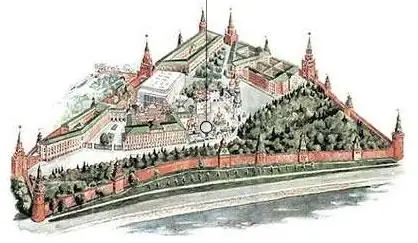- Author Harold Hamphrey [email protected].
- Public 2023-12-17 10:06.
- Last modified 2025-01-24 11:10.
Stoglavy Cathedral of 1551 marked a certain stage in the development of the state, society, religion and culture. At the time of the council, the Tsar of All Russia, Ivan Vasilyevich, was twenty years old, but he was the king "in power." Due to his young age, Ivan Vasilyevich was burning with a thirst for reforms so that the country would become a powerful power and Holy Russia.

The middle of the 16th century is considered the time of modernization, when Russia turned from an unsettled power into the strongest country in Europe and Asia. The Kazan and Astrakhan kingdoms were conquered, there was a war with the Crimean Khanate. The zemstvo dispensation of the Russian land began, when zemstvos were created, taking part in the administration of the state through their representatives. The army was modernized, and the nobility was formed, a new taxation system was introduced.
In the 15th century, the Byzantine Empire fell, a blow was de alt to the stronghold of Orthodox Christianity, and Russia took upon itself the burden of defending Orthodoxy. The task was set to equip Russia according to Orthodox laws, andthis required church reform. The religious consciousness of the laity was very high, for a Russian person the soul always stood in the first place, but the highest ranks of the clergy destroyed all the pillars of morality by their example.
The council began with the appeal of Tsar Ivan Vasilyevich to the assembled clergy. In his speech, which is described in the first chapters of the cathedral code (stoglavy cathedral), he spoke about how bad everything is in Holy Russia: the highest hierarchical circles of the clergy were mired in drunkenness, debauchery, sodomy, which was facilitated by property rights, that is, possession of inhabited lands.

Not only did the priests fatten themselves at the expense of the lands assigned to the monasteries, they also received “rugu” from the state treasury: wine, honey, food, clothes.
Ivan Vasilievich asked the clergy to help maintain almshouses, redeem captive people and give part of the monastery lands to the servants, but the high priesthood did not want to give up their possessions and treasury, and answered the tsar with a refusal.
Stoglavy Cathedral is 100 chapters of the cathedral code, which describe all the speeches, discussions and answers to the questions of the king, of which there were 69. The result of this council was the adoption of the following decisions:

- bring to deanery all church texts, that is, use only canonized ones;
- the service must be conducted in accordance with the full Charter;
- to overshadow oneself with a sign of two fingers;
- paint icons according to samples (according to Rublev and Grek);
- eradicateritual paganism;
- weddings were allowed from the age of 15 for boys and from 12 for girls;
- the hundred-headed cathedral forbade eating strangled and blood (animals and birds caught in snares);
- baptism was to be carried out by immersion in water three times, and not by dousing;
- the issue with the redemption of the Polonyanniks was resolved;
- supervision of the monastic treasury is imputed to the people of the sovereign, etc.
But the Stoglavy Cathedral could not arrange the life of the highest church nobility, who continued to live in sin and sodomy.
Stoglavy Cathedral is the most important document that shows how civilized Russian society was in the 16th century. Many historians, not attaching importance to such important reforms of those years, denigrated and humiliated the events of the Russian Middle Ages.






